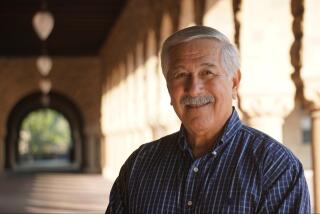Column: ‘American Dirt’s’ white author had the audacity to write about the migrant experience. Guess what, that’s OK
On Friday, the front page of this newspaper featured a story about the dragooning of boys as young as 6 by a vigilante militia in the Mexican state of Guerrero. Why visit such horror on little kids? To help fight rampant drug gangs.
“They must be prepared,” the militia leader told my colleague Kate Linthicum. “If they are afraid, the criminals will kill them like little chickens.”
Almost daily, in this and other newspapers, we read shocking stories out of Mexico and Central America: about drug cartel wars, migrant caravans, collapsing economies, corrupt law enforcement political malfeasance.
Of course, the stories paint a warped picture of life in Mexico, where millions of people live productive and happy lives in relative peace.
But, of course, it is the horror, not the quotidian reality, that makes its way onto the front page. It is the conflict and suffering that fire the imaginations of writers who want to tell stories about people buffeted by forces out of their control.
Which brings me to the new novel “American Dirt,” a riveting tale of a middle-class Mexican woman and her 8-year-old son on the run from a drug lord who has murdered their family. The pair flee Acapulco for the states, riding the top of La Bestia, the infamous and deadly freight train.
The novel is already a phenomenal success: Author Jeanine Cummins received a huge advance, the book has been optioned for a movie, and Oprah chose it for her book club. It is a novel about migration driven by desperation, certainly an important subject today.
“American Dirt” has also been the object of an intense backlash:
How dare the author create a migrant who is college educated, middle-class and has access to thousands of dollars thanks to her slain mother’s ATM card?
How dare she sprinkle the pages with Spanish words and phrases?
How dare she portray Mexico as a violence-addled country?
All of these criticisms boil down to one overarching objection:
How dare a white woman write about brown people?
::
On Thursday, I read “American Dirt” in one sitting. My heart pounded for 280 pages.
I found some of the writing beautiful, some painfully awkward. But mostly, I found it to be a hell of a tale about grief, survival and a mother’s love.
Foremost, “American Dirt” is a story about the perseverance of women.
Cummins has said she created her middle-class protagonist, Lydia, a bookstore owner married to a journalist, to turn the portrayal of the typical migrant “on its ear.”
The story is fanciful, far-fetched even. But so is the idea of conscripting 6-year-olds into militias.
Cummins didn’t just sit in a garret and make things up.
She has said she spent four years researching her subject, traveling extensively on both sides of the border, interviewing migrants, throughout Mexico and along the border as well as border patrol agents, immigration advocates, professors and other experts.
I wish Cummins had ended things there, that she let her work speak for itself.
Instead, in a fruitless effort to forestall criticism, she appended a self-defeating, four-and-a-half page, defensive author’s note to the end of the novel.
In it, she questions whether she has the right to tell this story, saying, “I wish someone slightly browner than me would write it.”
She explains that she was motivated to write the book “by the tenor of public discourse” around the issue of immigration. “At worst,” she writes, “we perceive [immigrants] as a mob of resource-draining criminals, and at best, a sort of helpless, impoverished, faceless brown mass, clamoring for help at our doorstep. We seldom think of them as our fellow human beings.”
Really? Who is this “we” of which she speaks? Perhaps she is forgetting that many of her readers are and will be immigrants, or the children of immigrants or, as I am, the grandchildren of immigrants.
Without that tone-deaf author’s note, my sympathies would have been fully with Cummins, because, bottom line, I believe anyone can write about anything.
As a journalist, I have to believe that. I write about all sorts of people with whom I have nothing in common.
Journalism and fiction, at their most effective, create bridges between worlds.
One of my favorite novels is “Sophie’s Choice” by William Styron, a white Southerner who had the audacity to tell the story of the Holocaust through the eyes of a Polish survivor of Auschwitz. Styron was criticized for making his protagonist a Catholic, but the novel fully embraced the enormity of the Holocaust and haunted me for years.
The more books written by authors from marginalized communities, the better, and the publishing world should do a better job, not just of finding such books but of giving their authors the kind of support Cummins has received.
And then, as with all works of art, let them be judged on their merits, not on the racial or ethnic identity of their makers.
More to Read
A cure for the common opinion
Get thought-provoking perspectives with our weekly newsletter.
You may occasionally receive promotional content from the Los Angeles Times.











